The Salesforce AppExchange is one of the most important places a business using Salesforce can go (barring maybe the help section of the Trailblazer Community!). Its 5,000+ solutions -- which include applications, application components, community and automation templates, and database integrations -- allow Salesforce customers to enhance, extend, and evolve their Salesforce functionality to solve virtually any business challenge.

While the breadth and diversity of the AppExchange offers something for everyone, it also requires businesses to carefully consider which apps are right for them. The quality and complexity of Salesforce AppExchange apps varies widely, especially when it comes to the crucial vetting and implementation process.
The benefits of discovering a great new business solution will be negated if the app doesn’t pass your organization’s security review. And an app that takes months to implement, or doesn’t fit into your Salesforce environment correctly, won’t grant you much ROI. Vetting/implementations gone wrong can reduce executive buy-in, stagnate user adoption, and nullify the benefits the app was supposed to bring to the table.
So how can you find quality apps that also make vetting and implementation a breeze?
You Might Also Like: How 2009 Changed the Salesforce AppExchange Forever
Not All Apps Are Created Equal
Salesforce AppExchange apps can be boiled down to two categories: native apps and non-native apps.
Non-native apps:
- Are built on external clouds and interfaced to Salesforce through APIs
- Require authorization of 3rd-party web connectors so data can be sent between Salesforce and the app’s servers
- Aren’t necessarily built for Salesforce exclusively, and may function on other platforms
Native apps:
- Are built entirely on the Salesforce platform
- Process all data within Salesforce and never require data to be sent off-platform
- Are built exclusively for Salesforce
Native apps allow you to accelerate the solution implementation process because they are built on the Salesforce platform, exclusively for Salesforce.
Don’t believe us? Just take a look at S-Docs, the only 100% native document generation and e-signature solution available on the AppExchange. Because of our native architecture, our customers are able to get set up and start seeing ROI immediately. G2 even awarded us these shiny badges for the Winter 2021 Salesforce CRM Document Generation Implementation Index!

But if that’s not enough for you, let’s get into the details on why native Salesforce applications can be implemented faster and start benefiting their customers before they’re even deployed to production.
You Might Also Like: How Native Salesforce Apps Reduce Total Cost of Ownership
1. Security Vetting is Easier with Native Salesforce Apps
Like we said before, native Salesforce apps are built on the Salesforce platform (formerly known as the force.com platform, now rebranded as the Lightning platform). This means that, quite simply, native apps never send customer data outside of Salesforce. Everything is 100% processed, delivered, and stored on Salesforce servers.
Since Salesforce has already been vetted and approved as a secure application, businesses evaluating native apps don’t have to worry about going through another lengthy platform assessment. Native apps run on the platform that they’ve already validated.
This can be especially liberating for IT teams in security-conscious industries like government, healthcare, or financial services.
2. Native Apps Require Zero Third-Party Integrations
Once you’ve installed an app into Salesforce, the last thing you want to worry about is jumping back out and configuring different accounts and connectors on third-party websites. Dealing with an entire separate interface, not to mention configuring APIs correctly, can be incredibly challenging, frustrating, and time-consuming.
Luckily, native apps allow you to skip all that. Once your native app is installed in your org (which only takes a few clicks from the AppExchange), the rest of the configuration steps happen right there where you work everyday. And there’s no need to get approval for third-party remote site authorization, since native apps function entirely within Salesforce.
You Might Also Like: [Datasheet] Native Salesforce App Architecture and Benefits
3. Native Apps Are Built Using Tools You Know
Even if you’re not a developer, you are probably familiar with the terms Apex, Visualforce, and custom objects. These are standard Salesforce development and customization tools -- your business likely has a few of them working in your org today. They’re also exactly what native apps are built with.
Because of this, native apps are much easier for Salesforce IT teams to implement -- they’re structured in a familiar way. Native apps also tend to mirror Salesforce’s look and feel, making the implementation process that much easier.
If you’re using a consulting firm to assist with your Salesforce implementation, native apps make their lives easier too. Salesforce consultants are Salesforce experts, so they’ll know exactly how to set up and navigate your app from day one.
4. Application Tests Are Faster with Native Apps
Every new Salesforce application that you download will likely need to go through testing in a sandbox org.
Whether your requirements necessitate one or one-thousand tests, native apps make it easier. For one, since they’re designed specifically for Salesforce, most native apps will allow you to easily migrate your application data from sandbox to production. Once testing is complete, you won’t lose any work and you can begin solving business problems with your app immediately.
In addition, native apps simply run faster. They operate entirely within your Salesforce environment, meaning that you don’t have to wait for web traffic between different clouds. This can exponentially speed up the testing process since you won’t be constantly stuck waiting for your app to process data. It will also probably reduce your stress levels, too.
You Might Also Like: How to Evaluate the Security of AppExchange Apps
5. Users Will Adopt Native Apps Faster
Users will only adopt a product if it helps them achieve a goal or makes their lives easier. If the product is too complex, takes too long to learn, or just doesn’t fit into their workflows, the likelihood of your business seeing ROI from it drops significantly.
Since native apps are built using the same building blocks as many of the other tools that Salesforce users interact with everyday, adoption will be a much easier process. Users will feel more comfortable learning and using a native app, since they’re designed to blend into your current workflows -- not clunkily integrate.
Faster adoption = a quicker end to the implementation process = speedier ROI.
Native Apps for Better Enterprise Solution Implementation
All in all, native Salesforce apps simply make the solution implementation process better. They’re easier to evaluate for data security purposes, faster to implement and test, and better at gaining immediate user adoption.
As with all things, you should always follow best practices when it comes to solution implementation to ensure it’s as seamless as possible. This includes:
- Defining specific needs and objectives, as well as who will be using the solution
- Surveying potential users for their input
- Gaining executive buy-in early
- Identifying potential risks of using the solution and challenging the solution provider on those issues
- Evaluating the implementation resources offered by the solution provider, and planning for resources that your organization will need to supply
- Establishing realistic expectations with your team
- Continuously monitoring adoption and maintaining communication with the vendor
By following these guidelines and evaluating native apps first, you’ll be well on your way to a better and more functional Salesforce org.
S-Docs: 100% Native Document Generation and E-Signature for Salesforce
Speaking of native apps, S-Docs is the only 100% native document generation and e-signature solution available on the Salesforce AppExchange. Create stunning documents with data pulled from anywhere in Salesforce, automate your workflows, and collect e-signatures -- 100% natively.
If you’re ready to get started with native document generation and e-signature (and implement quicker!), contact us today at sales@sdocs.com, or request a demo. We can’t wait to see what we can do to help your business succeed!







